Forestry can sometimes look like quite a destructive process. Felling on a large scale will often leave a site looking harsh and barren, scarred by the ruts and compaction left by the movements of huge machines. Even the immediate effects of coppicing can look fairly damaging, but of course we know that this is short lived and come the spring, the life and vitality will return in abundance.
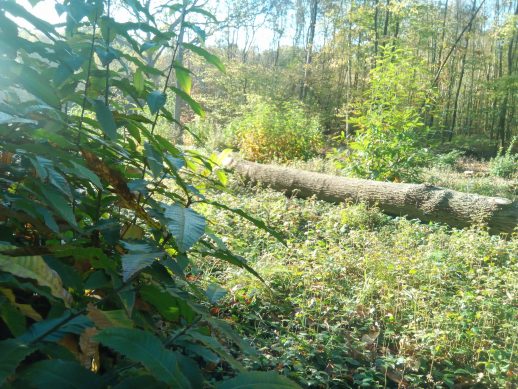
We also know the harsh realities of the economics behind small scale forestry, we know how difficult it is to make a living in the time honoured fashion of the coppice cycle and this is the reason why many of our woodlands have fallen dark and derelict; a resource undervalued, under used and superseded by cheap plastic products in a global economy.
Restoring these dark and derelict woodlands can be a real labour of love, but in amongst the fallen debris and tangled over stood stools, you will usually find some trees of value which are worth milling, either for your own use or to sell on. The big problem of course is getting to them and getting them out without the expense incurred in heavy machinery and without causing the damage we have already spoken of.
Horse logging is one solution, though not particularly cheap and not without some of the compaction problems. However, for a modest investment, smaller light weight milling systems can increase the viability of this kind of work by taking the mill to the tree instead of the tree to the mill. It works well in certain circumstances and with a little hard work can return some cash flow into your business. Smaller operations cannot hope to compete with the large scale sawmills but their big advantage is that these mills can be dismantled and walked into the wood by one or two people without causing any damage to the woodland floor.
This article will look at some of the techniques I’ve used to harvest this resource, mainly employing chainsaw mills or circular saw ‘swing arm’ mills (powered with a chainsaw ) but without resorting to the use of heavy moving and lifting equipment .
Chainsaw Mills
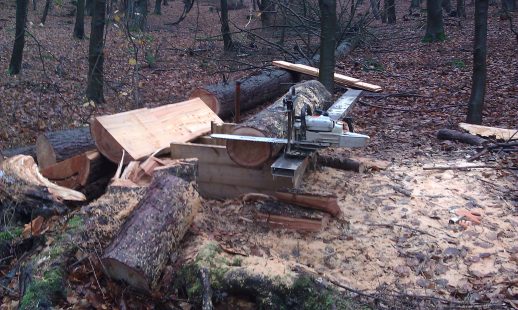 One of the simplest methods is to adapt your chainsaw to cut in a straight line along the grain, known as a ‘ripping’ cut. Chainsaw mills use a fairly standard but powerful chainsaw to achieve this . They can vary in their sophistication, but in essence you have a chainsaw held in some kind of jig or clamp which runs along a straight edge, the bar and chain transfers this straight edge to the log as it cuts. It is wise to purchase a bespoke ripping chain which has a much lower cutter angle or you can regrind your chain down to 10 degrees . There are quite a few models to chose from and many systems will have benches and little pulleys you can add to your system to make things easier.
One of the simplest methods is to adapt your chainsaw to cut in a straight line along the grain, known as a ‘ripping’ cut. Chainsaw mills use a fairly standard but powerful chainsaw to achieve this . They can vary in their sophistication, but in essence you have a chainsaw held in some kind of jig or clamp which runs along a straight edge, the bar and chain transfers this straight edge to the log as it cuts. It is wise to purchase a bespoke ripping chain which has a much lower cutter angle or you can regrind your chain down to 10 degrees . There are quite a few models to chose from and many systems will have benches and little pulleys you can add to your system to make things easier.
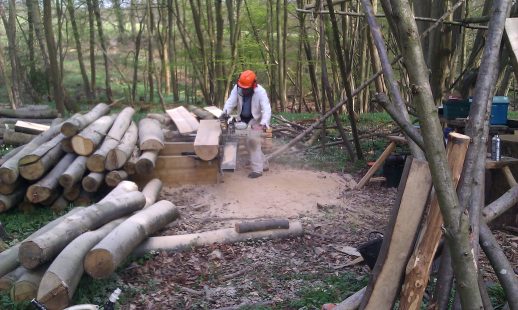
This logosol version has a bespoke beam to run the saw and jig along. A homemade bench, some dogs to hold the log steady and calibrations which can fairly accurately size timber for subsequent cuts.
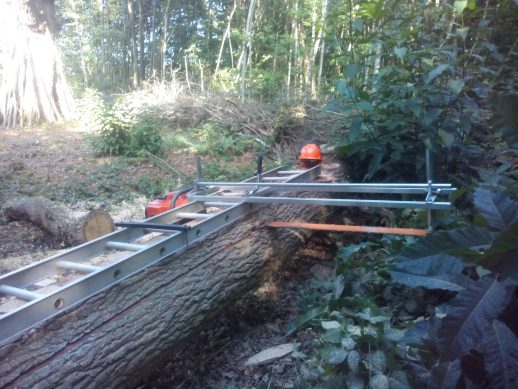
The Alaskan mill holds the nose of the bar as well and can run along any straight edge you might have. Most people find an aluminium ladder does the job. I’ve found it to be a very accurate way of producing wider slabs or boards.
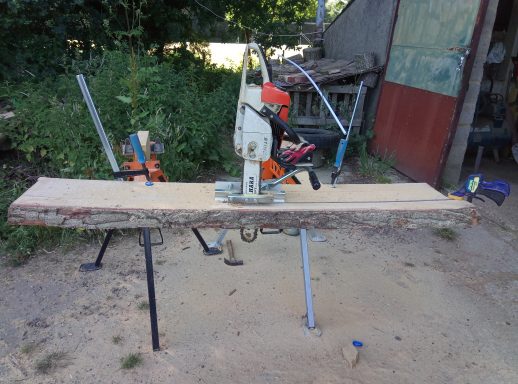
You can also buy a nose guide which will put a straight edge on your boards, or in this case a slight curve for the wind braces on a timber frame.
Cutting with the grain is hard work on the saw and it means that it really needs to be meticulously sharpened and maintained that way. I have a 5 foot bar and chain which I use for cutting oak slabs up to about 40″, I think it has has 172 cutters, all of these need to be razor sharp and of the exact same length. It can be a bit daunting if after 2 or 3 cuts, it’s gone dull and needs resharpening. In this scenario it would be worth investing in a mechanical sharpener, something like the Granburg 12v precision grinder which will still take some time to sharpen, but will keep all your cutters the same angel and size. Importantly it will reduce the stress put on the saw and the operator.
Pros
• Very convenient, one person can walk into the wood and set it up alone.
• Very light weight Can be set up in most difficult to get at sites.
• Good for the occasional wind blow or small orders of bespoke high value timber
• Low initial investment , however you will need a fairly powerful saw depending on the size of timber you want to mill
Cons
• can be tediously slow cutting and maintaining
• A lot of waste the wider your saw cut (kerf) the more waste, a .404 chain will displace over 10 mm of sawdust per cut in the kerf
Swing Arm Mills
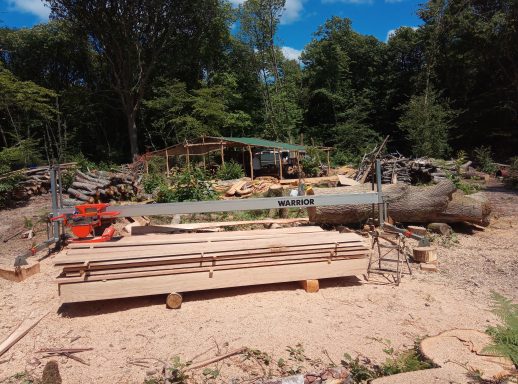 Not quite as portable as the chainsaw mills, however, swing arm mills are gaining in popularity. They can still be dismantled and walked into the wood, but are a much faster and a more efficient way of producing dimensional timber.
Not quite as portable as the chainsaw mills, however, swing arm mills are gaining in popularity. They can still be dismantled and walked into the wood, but are a much faster and a more efficient way of producing dimensional timber.
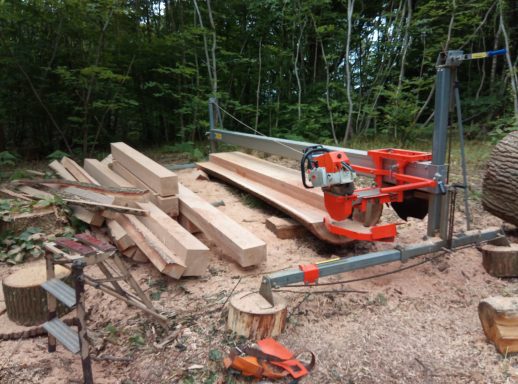 This model is powered by a large chainsaw which drives a circular saw blade instead of a chain. The whole carriage which it runs on is able to ‘swing’ through 90 degrees, so it can cut in both horizontal and vertical planes to produce boards or beams straight off the tree.
This model is powered by a large chainsaw which drives a circular saw blade instead of a chain. The whole carriage which it runs on is able to ‘swing’ through 90 degrees, so it can cut in both horizontal and vertical planes to produce boards or beams straight off the tree.
Set up time is a considerably more for machines like this so it is more efficient to concentrate on milling up larger trees in situ.
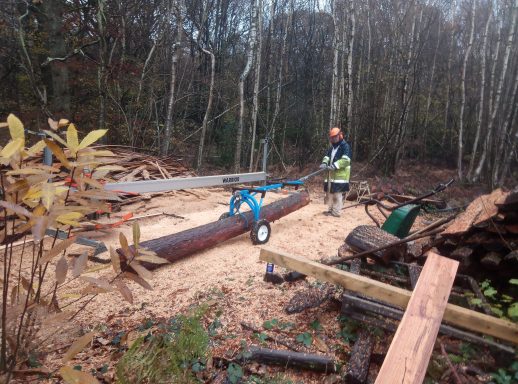 However logs under 16” in diameter which will fit in my logging arch are still worth processing and with a little help from gravity, can usually be manoeuvred onto the mill in a convenient lower spot in the wood.
However logs under 16” in diameter which will fit in my logging arch are still worth processing and with a little help from gravity, can usually be manoeuvred onto the mill in a convenient lower spot in the wood.
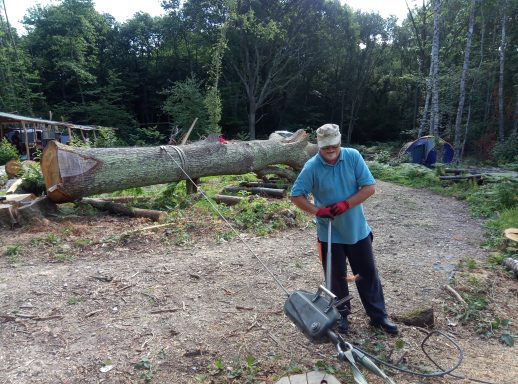 Bigger trees require more work manoeuvring them off the stump and turning them for the best orientation before building the mill around it.
Bigger trees require more work manoeuvring them off the stump and turning them for the best orientation before building the mill around it.
Rolling an oak butt off the stump and on to bearers with a hand winch ready for milling.
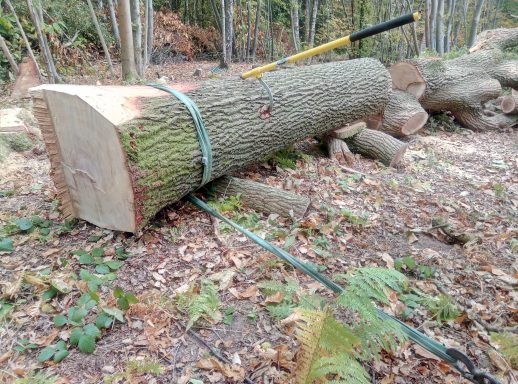 The butt can also be skidded on to bearers by attaching the strop to bottom of the log, this means you can get it into the most efficient orientation for milling.
The butt can also be skidded on to bearers by attaching the strop to bottom of the log, this means you can get it into the most efficient orientation for milling.
The usual warnings apply when manipulating large logs by hand. Take extreme care and carefully plan each move using chocks and wedges to prevent the log from getting out of control.
Pros
• Convenient, two people can walk it into the wood
• Quite light weight, can be limited in how far it can feasibly be carried
• Good for a wide size range of saw logs
• Produces accurate dimensional timber
• If you opt for a chainsaw version as your power source, you can use the chainsaw with an Alaskan Mill set up.
• The circular saw has a smaller kerf than the chainsaw
Cons
• Expensive outlay
• Can take a bit of time to set up so choice of trees needs to be factored in for maximum efficiency
• Distance from your truck or trailer is limited to how far you can/are prepared to carry it.
Overall these two different systems have their place, but a lot will depend on what kind of wood you have as to whether or not it is worth investing in one or both of them. For me it works because I manage woodlands in the area which have trees that I and others can use. However it is a fine line and it’s not going to make you a millionaire, but if you count the fact that you are really doing two jobs: selling high value timber and restoring and managing the woodland in the most sensitive way possible then this should really be included in your perceived remuneration and make it a worthwhile and very satisfying process.
For more information contact [email protected]